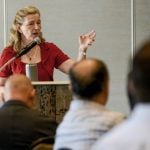When Canada’s rural and urban municipal leaders met in June 2008, Toronto mayor David Miller pulled rural Alberta leader Don Johnson aside with an unexpected request.
Could the mayor of Canada’s largest city speak to a meeting of the Federation of Canadian Municipalities rural caucus, which Johnson chairs?
“It took me just a few seconds to say yes,” Johnson said.
“David and I had developed a good relationship, often jointly presenting.”
However, the announcement that the big city mayor would be speaking to the rural caucus produced head scratching among its members. What would Miller say that would be relevant to the residents of the Municipal District of Taber in Alberta, Johnson’s political base?
Read Also

Agriculture ministers agree to AgriStability changes
federal government proposed several months ago to increase the compensation rate from 80 to 90 per cent and double the maximum payment from $3 million to $6 million
As it turned out, Miller brought the house down.
“His message was essentially that Toronto’s economic well-being is absolutely dependent on what is happening in the rural areas around it,” said Johnson.
“To say the least, it was well received.”
Johnson, president of the Alberta Association of Municipal Districts and Counties, was not surprised. He and Miller had been working together for almost four years.
In fact, Miller’s leadership in 2004 had been instrumental in making sure that the federal promise to return billions of dollars in gas tax revenue to municipalities for infrastructure investment also benefitted rural municipalities with small populations. The distribution formula was tweaked to make sure it was not based strictly on population, which would have given cities a disproportionate share.
“There had been a rural-urban split in the FCM and Paul Martin was insisting on a consensus or he might walk away from the commitment,” Johnson said.
“Our agreement, promoted by David Miller, took away any excuse for the prime minister not to act.”
The result is $37 million in gas tax infrastructure money for rural Alberta municipalities and as much as $350 million annually for rural infrastructure countrywide.
For Miller, it was a question of fairness.
“We wanted to make certain that the federal funding would meet the needs of the big urban area and all rural areas,” he said in an interview in his downtown Toronto office.
“If you have funding on a population basis, Toronto gets quite a bit and small places very little, not enough to build a water plant if that’s what’s needed.”
Miller is an advocate of co-operation and more understanding between the rural and urban solitudes. He understands that many rural residents see Toronto as the place they love to hate, a city that can’t even produce a real hockey team.
It cuts both ways.
Torontonians make up the most ethnically diverse city in the world, elect Liberals and New Democrats and see rural areas as old white places that elect Conservatives.
“They don’t understand that behind that Conservative vote there is a tremendous sense of community that is being expressed.”
Miller said he gets his empathy for rural areas naturally. He grew up in a small farming village in England with a blacksmith and working farms.
“In my heart, that’s who I am,” he said. “I’m this little boy from this tiny farming village, so that gives me a perspective that informs my thinking on this.”
















